Unique looking and great tasting Picasso potato from Holland
The late-ripening Dutch Picasso potato got its name in honor of the "pink" period of creativity of the Spanish painter, sculptor and designer Pablo Picasso, which lasted from 1904 to 1906. He painted his canvases in pink-yellow and pink-gray tones. Each Picasso tuber really resembles a work of art - the skin is painted in a light yellow shade with pink splashes in the eye area.
From the article you will learn about the features of agricultural technology of the variety, its advantages and disadvantages, methods of combating late blight and pests.
The content of the article
Description of the variety and history of creation
Picasso potatoes are a product of the selection work of biologists of the Dutch company AGRICO U. A.
Among the patent holders:
- LLC Alchak;
- ZAO Oktyabrskoe;
- LLC Agrofirma Slava Potato;
- LLC ETK "Meristemnye kultury";
- CJSC "Breeding farm" Prinevskoye ";
- FSBSI "All-Russian Research Institute of Potato Farming" A.G. Lorkha ";
- SPK "Agrofirma" Elite Potato ".
Reference. The people call this potato differently: Lyska, Limonka, Drunkard, Ryabukha.
Pictured - Picasso potatoes.

Distinctive features and description of appearance are presented in the table.
| Indicators | Characteristic |
| Ripening period | 110-120 days |
| Bush | Tall, spreading, intermediate type |
| The number of tubers in the bush | 15–19 |
| Weight | 75-126 g |
| The form | Round oval |
| Coloration | The skin is yellow, with pink blotches and small eyes, the flesh is creamy |
| Leaves | Large, dark green color |
| Corolla color | White |
| Starch content | 7,9–13,5% |
| Taste | Excellent (5 on a five-point scale) |
| Cooking class / group | A / B (non-crumbly or slightly crumbly) |
| Yield | In the Central Region - 193-315 c / ha, in the Central Black Earth Region - 190 c / ha |
| Marketability | 79–94 % |
| Keeping quality | 83–90 % |
| Appointment | Dining room |
| Sustainability | Cancer, nematode, leaf rolling, common scab |
| Transportability | High |
Agricultural technology varieties
Picasso potatoes unpretentious in care, resistant to drought and heat, grows on any type of soil, but in order to obtain a rich harvest and maintain taste, it needs organic and mineral dressings.
Agrotechnical techniques - standard... The bushes are watered as the soil dries up, regular loosening, weeding, hilling, preventive treatments against fungi and insects are carried out.
Other varieties of potatoes:
Timing, scheme and landing rules
 Picasso potatoes belongs to late-ripening varieties, therefore, planting is carried out 2-3 weeks earlier than early ripening crops are planted - in the last decade of April, provided the air warms up to a temperature of + 7 ... + 10 ° С.
Picasso potatoes belongs to late-ripening varieties, therefore, planting is carried out 2-3 weeks earlier than early ripening crops are planted - in the last decade of April, provided the air warms up to a temperature of + 7 ... + 10 ° С.
Germinating tubers before planting is optional.however, this procedure speeds up maturation. Seed material is taken out of the cellar 20-25 days before planting in a warm, bright place (room temperature + 15 ° C), sorted, soaked in "Epin" or "Zircon" according to the instructions. Then it is treated with a disinfectant solution of potassium permanganate or "Fitosporin". Tubers are laid out in one layer on a flat surface and wait for germination.
On the site before planting sow wheat, lupine, rye, flax, mustard, in a month they are mowed and embedded in the ground. Green manures saturate the soil with nutrients, loosen, prevent the growth of fungi.
They are planted in holes 20 cm deep. Large seeds are cut into two parts, the cut is sprinkled with ash. A handful of wood ash and 25-30 g of superphosphate are added to each. The distance between the pits is 40-50 cm. This rule is due to the spreading structure of the bushes. Thickening of the plantings leads to the uprooting of tubers and greening under the influence of ultraviolet radiation. The width between the rows is 60–70 cm.
Care
Planting care rules:
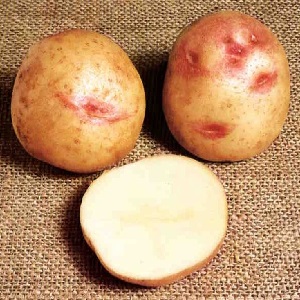 Rainwater is enough for Picasso potatoes: they do not need systematic watering. But in hot, dry weather, the bushes are watered from a watering can on their own - 1 time in 10 days. The installation of a drip system on the site will help to minimize labor costs.
Rainwater is enough for Picasso potatoes: they do not need systematic watering. But in hot, dry weather, the bushes are watered from a watering can on their own - 1 time in 10 days. The installation of a drip system on the site will help to minimize labor costs.- Weeding and loosening are mandatory procedures to saturate the rhizome with moisture and oxygen. They are carried out when the seedlings reach 6-7 cm in height.
- Hilling allows you to simultaneously remove weeds and oxygenate the roots. The first time the plants are spudded 2-3 weeks after planting, again after flowering.
- Harrowing is carried out in large areas (2-3 ares). A harrow is hooked onto a tractor or walk-behind tractor, the teeth of which tear out weeds from the soil, deeply loosening the earth.
- Picasso is fertilized with organic and mineral fertilizing three times: after germination, before flowering and during flowering.
Top dressing scheme:
- 1st portion (two weeks after germination): infusion of chicken manure (1 tbsp. L dry organic matter / 10 l) or 500 g mullein, 25 g urea / 10 l warm water;
- II portion (before flowering): 15 g of potassium sulfate, 15 g of superphosphate / 10 l of water;
- III portion (during flowering): 100 g superphosphate / 10 l or 2 g sodium humate / 10 l (for foliar planting).
Reference. Potatoes absorb only 50% of the active ingredients during root fertilization. The plant absorbs minerals most actively when spraying the ground part.
The nuances of growing and possible difficulties
 Picasso variety shows the best results when cultivated in the Central and Central Black Earth region... Nevertheless, the crop is grown in other areas of the country, harvesting an excellent harvest, but in different volumes.
Picasso variety shows the best results when cultivated in the Central and Central Black Earth region... Nevertheless, the crop is grown in other areas of the country, harvesting an excellent harvest, but in different volumes.
Farmers in the southern regions face growing difficulties... In the constant sun, the tubers degenerate; in early June, their development partially stops. To preserve the harvest, gardeners are constantly experimenting. For example, potatoes are planted in the first ten days of July to bypass the peak of the heat. The long warm period in the southern regions allows harvesting in late autumn.
Besides the traditional way of growing potatoes practice planting in the grass without digging the earth... It is much easier and faster. An important nuance - you first need to make a large supply of grass, hay or straw.
On an area with grass, they mark the beds using rope and pegs. The row spacing is 50-60 cm. In the marked beds, 2-3 tubers are laid out with an interval of 20-30 cm in a checkerboard pattern. On top, a flooring of mulch is made with a layer of 20 cm. During the growing season, all collected weeds are poured onto the beds, renewing the mulch layer.
Diseases, pests and methods of dealing with them
Picasso is susceptible to late blight of tops and tubers... The disease manifests itself in the form of dark spots on tubers and greenery, whitish bloom on the back of the leaves. To prevent late blight infection, after 15–20 days planting is sprayed with Bordeaux liquid or pollination with wood ash.
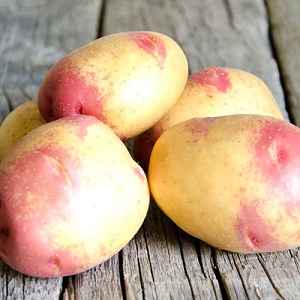 If the infection could not be avoided, for treatment use:
If the infection could not be avoided, for treatment use:
- before flowering - "Ridomil Gold MC", "Oksikhom" (twice with an interval of 10 days);
- after flowering - "Bravo" (three times every 10 days);
- before digging potatoes - one-time treatment with "Alufit".
Preventive measures include:
- crop rotation, keeping the distance between plants;
- selection of a site on the south side with good ventilation;
- disinfection of planting material with "Immunocytofate", potassium permanganate or copper sulfate before planting;
- harvesting in dry, sunny weather;
- fertilization with potassium and phosphorus;
- control of nitrogen levels in the soil.
Wireworm larvae are dangerous for potatoes, gnawing through holes in tubers. To get rid of the pest, a click beetle, ground beetles, starlings, thrushes, rooks, wagtails, tits are attracted to the site, and the beds are sprinkled with ground eggshell or ammonium nitrate (30 g / 1 m²). The drugs "Decis", "Actellik", "Barguzin" effectively destroy the larvae.
Potato tops are a favorite treat of the Colorado potato beetle... To scare him away, lupine and mustard are sown next to the beds. The bushes are treated with chemical agents: "Tabu", "Prestige", "Aktara", "Killer", "Fitoverm", "Colorado potato beetle NO!", "Corado".
Among the popular methods of pest control:
- Dusting with corn flour. Small particles swell in the digestive system of the larvae, causing their death.
- Poplar. A bucket of 10 liters by ½ is filled with leaves, filled with water and boiled for 15–20 minutes. Cool and bring the volume to 10 liters after 3 days start spraying the plantings.
- Sunflower. 500 g of flowers are poured into 10 liters of water and insisted for 3 days.
- Celandine. 1.5 kg of freshly cut grass is poured into 10 liters of hot water. After 3 hours, add 1 l of a solution of 1.5% calcium chloride.
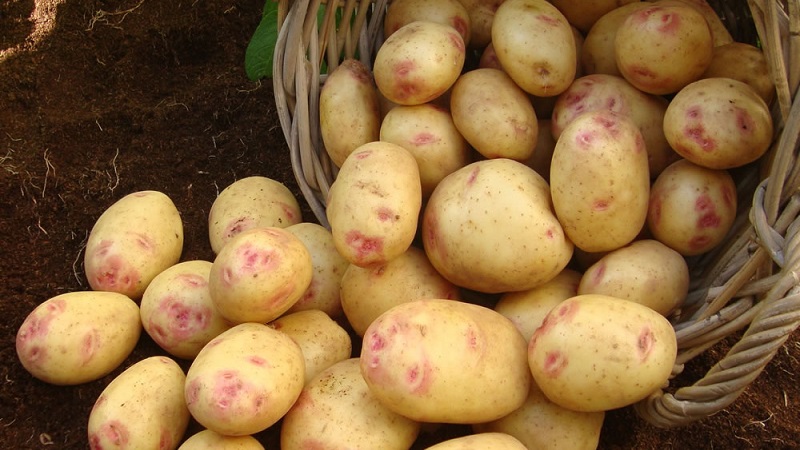
Read also:
Collection, storage and use of the crop
Harvested on a dry, sunny day in mid-September when landing in May. Three weeks before harvest, stop any treatment with chemicals, herbal infusions and minerals.
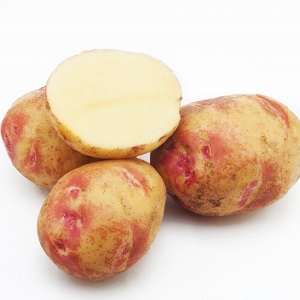 Due to the late ripening the tubers are kept cool until the next season and do not germinate... The safety of the crop depends on compliance with the rules of harvesting.
Due to the late ripening the tubers are kept cool until the next season and do not germinate... The safety of the crop depends on compliance with the rules of harvesting.
The potatoes are sorted, choosing only healthy, undamaged specimens, laid out in one layer in a dry dark room for 3-4 days to dry. Then they are laid out in a container for storage. Plastic, wooden boxes and linen bags will do.
Potatoes keep well with beetswhich is laid out on top. Root vegetables absorb moisture, preventing potatoes from rotting.
Household thermo containers are suitable for storing crops on the balcony.resembling large backpacks. They are hung on fixtures in the wall or set on a hill so that the bottom does not touch the ice floor in winter.
The balcony cellar is produced in three variations:
- 100 liters (holds 1 bag of potatoes);
- 180 liters (2 bags);
- for 300 liters (3 bags).
Tubers are regularly examined and sortedcompletely taking out their storage. Rotten and green fruits are thrown away.
Picasso potatoes suitable for preparing a variety of dishes... The optimal starch content (7.9-13.5%) allows you to boil tubers in water and steam, stew, fry, bake. The potatoes are not boiled during the heat treatment.
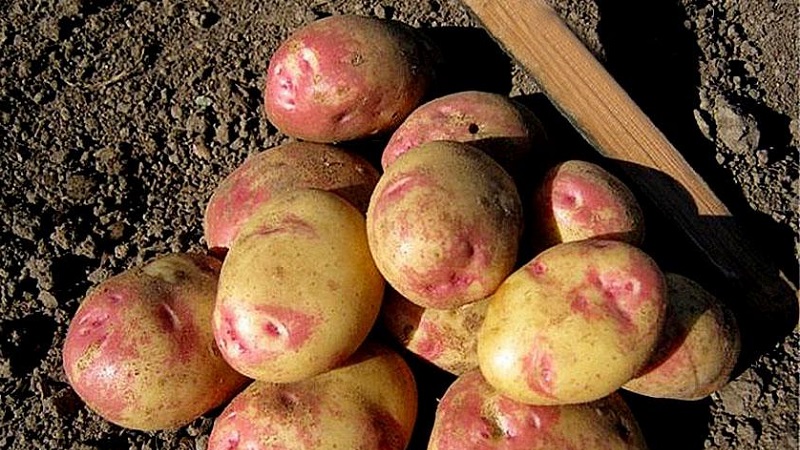
Advantages and disadvantages
The advantages of Picasso potatoes include:
- excellent taste;
- optimal starch content;
- attractive presentation;
- keeping quality;
- high level of transportation;
- resistance to most "potato" diseases;
- drought resistance;
- unpretentious care.
Disadvantage - susceptibility to late blight of tops and tubers.
Which regions is best suited for
Favorable growing regions Picasso potatoes:
- Central, including the Bryansk, Vladimir, Ivanovo, Kaluga, Moscow, Ryazan, Smolensk, Tula regions;
- Central Black Earth, with the Belgorod, Voronezh, Kursk, Lipetsk, Oryol and Tambov regions included in it.
Reviews
Farmers' reviews of the Picasso variety are mostly positive. However, there are also negative ones - not everyone is happy with its taste.
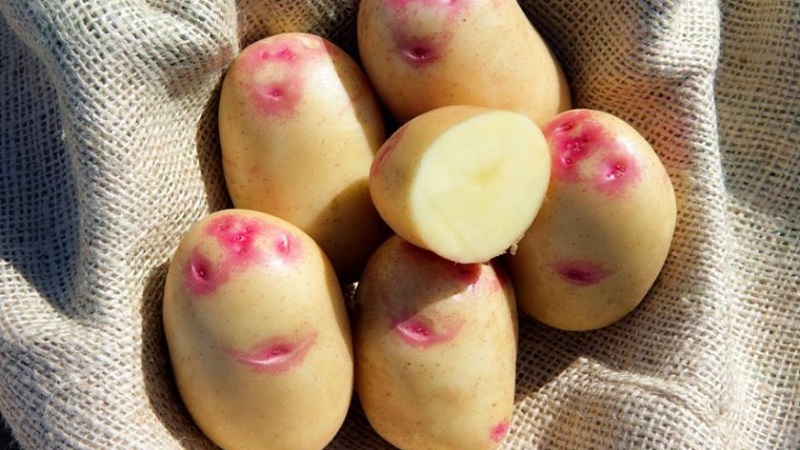
Valery, Valuyki: “We have come to love this variety for a long time. Initially attracted by an interesting appearance - a yellow skin with pink eyes.And then we realized that the potatoes tasted great. The yield is high, we collect about 20 tubers from one bush. The culture in the care is unpretentious, but requires the introduction of organic and mineral fertilizers ".
Ludmila, Oboyan: “Last year I planted several rows of these potatoes and reaped a rich harvest. I didn't like the taste of the potato, it breaks when frying. Stored without problems, does not grow. I will not plant any more, there are varieties that are much tastier ".
Olga, Glazunovka: “This is the most popular variety on our market. We grow potatoes for sale, and Picasso is bought up first. This is facilitated by a beautiful lemon-colored peel with pink splashes and tasty pulp with a pronounced potato aroma. Care is simple, consists of moderate watering, weeding and the introduction of organic matter with minerals ".
Conclusion
The Picasso variety is characterized by a late ripening period, allowing the harvest to be stored until the next season. The tubers are uniform and medium in size. The skin has an interesting color - yellow-pink, which attracts the attention of buyers. The universal purpose in cooking provides an optimal starch content (7.9-13.5%), so potatoes can be boiled, fried, baked, stewed without fear that they will turn into porridge during cooking.
The culture is susceptible to infection with late blight tops and tubers, but timely preventive treatment and adherence to the rules of agricultural technology prevents infection.